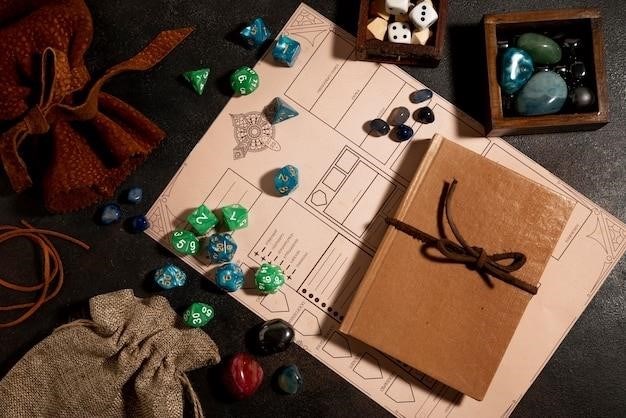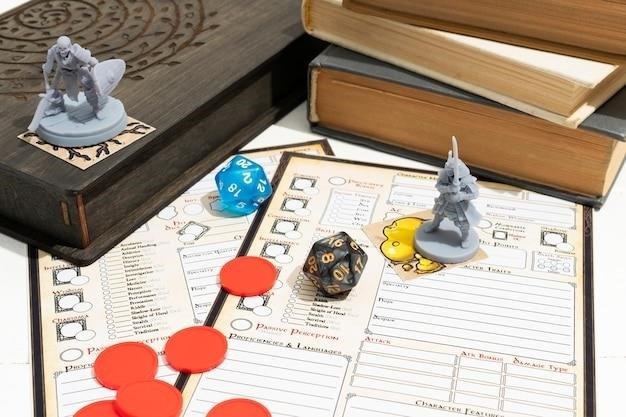
dnd 5e fighter guide
D&D 5e Fighter Guide⁚ Mastering the Art of Combat
The Fighter class is a mainstay in Dungeons & Dragons 5e, known for its prowess in combat and adaptability. This guide will delve into the intricacies of the Fighter, offering insights into its features, archetypes, optimization strategies, and tips for playing this classic warrior class;
Introduction
In the realm of Dungeons & Dragons 5e, the Fighter stands as a bastion of martial prowess, a stalwart defender, and a formidable force on the battlefield. This class embodies the quintessential warrior, wielding a variety of weapons and armor with unmatched skill. Fighters are renowned for their durability, their ability to dish out hefty damage, and their versatility in combat. They are the heart of many adventuring parties, providing a reliable front line and a steady source of damage output.
The Fighter class is a great choice for players who enjoy the thrill of combat and the satisfaction of dealing significant blows to their enemies. They are also a good option for players who want to be the party’s main damage dealer or tank, standing between their allies and harm. If you’re drawn to the image of a valiant warrior, a fearless knight, or a cunning duelist, the Fighter might be the perfect class for you.
This guide will be your comprehensive resource for understanding and mastering the Fighter class in Dungeons & Dragons 5e. We’ll explore everything from basic class mechanics to advanced strategies, covering all the essential aspects of playing a Fighter effectively.
Class Features and Mechanics
The Fighter class in Dungeons & Dragons 5e is defined by its core features, which grant it the ability to excel in combat and provide valuable support to the party. These features are the foundation of the Fighter’s strength and versatility, allowing them to adapt to various combat situations and playstyles.
One of the defining features of the Fighter is its proficiency with all weapons and armor, making it a truly versatile warrior. Fighters can choose from a wide array of weapons, from simple swords and axes to more exotic options like polearms and bows, allowing them to tailor their combat style to their preferences. They also have proficiency in all armor types, from light leather to heavy plate, allowing them to choose the level of protection that suits their needs and playstyle.
Fighters gain multiple attacks as they level up, allowing them to strike multiple times in a single round. This feature, combined with their proficiency in weapons and armor, makes them a formidable force on the battlefield. Additionally, Fighters have a hit die of d10, providing them with a solid amount of hit points, making them durable in combat.
Martial Archetypes
Martial Archetypes, also known as subclasses, provide Fighters with specialized skills and abilities that enhance their combat capabilities and define their specific role within the party. Each Archetype offers a unique path for the Fighter, allowing players to customize their character and adapt to various playstyles and team compositions.
The Battle Master archetype, for example, provides tactical flexibility with maneuvers like Disarming Attack or Pushing Attack, allowing Fighters to control the battlefield and manipulate enemies. The Champion archetype focuses on raw damage output, gaining powerful critical hit abilities and increased accuracy. The Eldritch Knight, on the other hand, combines martial prowess with magic, granting access to spells and spellcasting abilities, allowing them to weave magic into their combat strategies.
Other Archetypes, like the Samurai, the Rune Knight, and the Battle Master, each offer a distinct set of abilities, allowing Fighters to specialize in different combat roles. Whether it’s leading the charge as a fearless warrior, supporting allies with battlefield control, or harnessing the power of magic, Martial Archetypes provide Fighters with the tools to become masters of the art of combat and valuable assets to any party.
Choosing Your Race
Race selection is a crucial step in building a Fighter, as it influences their starting ability scores, resistances, and racial features that can enhance their combat capabilities. For a Fighter focused on strength and heavy armor, races like Mountain Dwarves, Orcs, and Half-Orcs offer excellent starting bonuses to Strength and Constitution, making them ideal choices for tanking and dealing heavy damage.
For those who prefer a more agile fighting style, races like Wood Elves, Tabaxi, and Leonin provide bonuses to Dexterity, allowing for increased accuracy and agility in combat. Wood Elves, with their proficiency in Perception, are particularly well-suited for ranged combat, while Tabaxi’s natural stealth and speed grant them an advantage in flanking and initiating attacks.
Ultimately, the best race for a Fighter depends on your preferred playstyle and the specific Martial Archetype chosen. Consider your desired combat role, the benefits of each race’s features, and how they align with your character’s backstory and personality to create a well-rounded and effective Fighter.
Ability Scores and Stats
Ability scores are the foundation of any character in D&D 5e, determining their inherent strengths and weaknesses. For Fighters, the most important ability scores are Strength and Dexterity. Strength is paramount for melee fighters, enhancing their damage output with weapons and their ability to wield heavy armor. Dexterity is crucial for ranged fighters and those who prefer a more agile fighting style, increasing their accuracy, initiative, and ability to dodge attacks.
Constitution is another vital stat for Fighters, as it directly impacts their hit points, making them more resilient in combat. Intelligence, Wisdom, and Charisma are less crucial for Fighters, but they can still be valuable depending on your chosen Martial Archetype and playstyle.
When allocating ability scores, prioritize Strength or Dexterity based on your preferred combat role, followed by Constitution for resilience. Consider distributing the remaining points to other scores based on your chosen Martial Archetype or any specific skills or feats you wish to specialize in.
Feats and Skills
Feats and skills provide Fighters with specialized abilities and knowledge, enhancing their effectiveness in combat and other situations. Feats offer a powerful way to customize your character, granting access to unique abilities and bonuses. For Fighters, feats like Sharpshooter, Great Weapon Master, and Crossbow Expert enhance their damage output, while feats like Sentinel, Defensive Duelist, and Alert improve their combat survivability and tactical options.
Skills are essential for broadening your character’s capabilities beyond combat. Fighters are proficient in Athletics, Acrobatics, Perception, and Intimidation by default, allowing them to excel in physical challenges, stealth, awareness, and imposing their will on others; Consider selecting additional skills based on your chosen Martial Archetype, background, and playstyle, such as Stealth for a stealthy fighter, Persuasion for a charismatic leader, or Arcana for a fighter with magical leanings.
Carefully choose your feats and skills to complement your chosen Martial Archetype, enhance your combat prowess, and add depth to your character’s personality and abilities.
Equipment and Gear
Fighters, as masters of martial combat, rely on a wide array of equipment and gear to enhance their effectiveness in battle. Their proficiency in heavy armor makes them formidable on the front lines, capable of enduring heavy blows. Plate armor, chain mail, and scale mail offer the best protection, while lighter options like studded leather and leather armor provide a balance of protection and mobility.
The choice of weapons depends on the fighter’s preferred fighting style and specialization. Melee weapons like longswords, great swords, and axes provide significant damage, while finesse weapons like rapiers offer precision and agility. Ranged weapons like bows and crossbows provide tactical advantages, allowing fighters to engage enemies from a distance.
Accessories such as shields, potions, and spell scrolls contribute to a fighter’s overall effectiveness. Shields provide extra protection, potions offer temporary boosts, and spell scrolls provide access to magical abilities. Consider investing in these items to increase your fighter’s survivability and tactical options.
Multiclassing Options
While Fighters excel in martial combat, multiclassing opens up exciting possibilities to expand their capabilities and create unique hybrid characters. Combining the Fighter with classes like Paladin, Ranger, or Barbarian can enhance their combat prowess, adding divine power, wilderness skills, or primal rage to their repertoire.
For example, a Fighter/Paladin multiclass can become a holy warrior, combining the Fighter’s martial skills with the Paladin’s divine abilities. A Fighter/Ranger multiclass can become a skilled hunter, blending the Fighter’s combat prowess with the Ranger’s wilderness expertise. A Fighter/Barbarian multiclass can become a fearsome berserker, combining the Fighter’s martial training with the Barbarian’s primal rage.
When choosing multiclass options, consider the benefits each class brings to the table and how they complement the Fighter’s strengths. Remember to meet the prerequisites for multiclassing, such as minimum ability scores and proficiencies. Multiclassing allows you to create a character that embodies the best of both worlds, making them a truly formidable force in the game.
Playing a Fighter⁚ Tips and Strategies
Mastering the art of combat as a Fighter requires understanding both the tactical and strategic aspects of battle. Here are some tips and strategies to enhance your Fighter’s performance⁚
- Positioning is Key⁚ Utilize your mobility to position yourself strategically, maximizing your damage output while minimizing your exposure to danger.
- Embrace Your Role⁚ Fighters excel at front-line combat. Don’t shy away from engaging the enemy directly, providing a shield for your allies and attracting the attention of foes.
- Maximize Your Attacks⁚ Fighters are known for their multi-attack capability. Use this to your advantage, striking multiple times in a single round to inflict significant damage.
- Utilize Your Abilities⁚ Don’t neglect your class features and abilities. Use them wisely to gain an edge in battle, whether it’s a Battle Master’s maneuver or a Champion’s critical hit bonus.
- Work With Your Party⁚ Coordinate with your allies to maximize the effectiveness of your attacks. For example, a spellcaster might use a spell to weaken an enemy, making it easier for you to land a critical hit.
Remember, a skilled Fighter is more than just a brute force. Combine tactical positioning, strategic thinking, and masterful use of abilities to truly dominate the battlefield.

The D&D 5e Fighter is a versatile and powerful class, offering a variety of playstyles to suit different preferences. Whether you prefer the classic warrior archetype, a more tactical Battle Master, or the relentless might of a Champion, the Fighter provides ample opportunities for engaging in combat and contributing to the success of your party.
Remember, the key to playing a successful Fighter lies in understanding the class’s strengths and weaknesses, utilizing its abilities strategically, and working effectively with your allies. By mastering the art of combat, you can transform your Fighter into a formidable force on the battlefield, a stalwart protector for your companions, and a true hero of legend.
This guide has served as a starting point for your journey as a Fighter. Continue to explore the class’s nuances, experiment with different strategies, and embrace the thrilling challenge of mastering the art of combat in the world of Dungeons & Dragons.